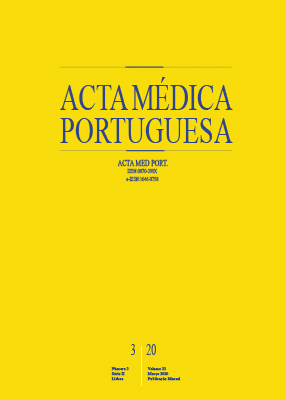Undiagnosed Risk of Obstructive Sleep Apnea in Obese Individuals in a Primary Health Care Context
DOI:
https://doi.org/10.20344/amp.12319Keywords:
Obesity, Portugal, Primary Health Care, Sleep Apnea, Obstructive/diagnosis, Surveys and QuestionnairesAbstract
Introduction: Obstructive sleep apnea is a clinical entity that is associated with an increase in morbidity and mortality and it is estimated that it is significantly undiagnosed. The objective of this study was to assess the risk of undiagnosed obstructive sleep apneain obese individuals.
Material and Methods: A descriptive and analytical cross-sectional study; the risk of obstructive sleep apnea’s was assessed over a period of 11 months by applying the STOP-Bang questionnaire to all individuals who attended a family health unit who were aged ≥ 18 years and had body mass index of ≥ 30 kg/m2 and who had not yet been diagnosed with obstructive sleep apnea and agreed to participate; the risk of an undiagnosed moderate to severe obstructive sleep apnea was considered for any STOP-Bang score of ≥ 3.
Results: The risk of undiagnosed obstructive sleep apnea was assessed in 888 individuals (59.3% females) with an average age of 59.6 ± 14.68 years and a mean body mass index 33.6 ± 3.43 kg/m2; the mean STOP-Bang score was 3.5 ± 1.74, 70.9% scored ≥ 3; the frequency of all STOP-Bang questionnaire parameters was higher (p < 0.004) within the group with score ≥ 3.
Discussion: The studied population is one of the main strengths, since it is in obese people that the incidence of this disease is higher. There are some limitations related to this sample coming from a single family health unit, as well as the patients’ follow-up being carried out throughout routine appointments for diseases that are closely related with obstructive sleep apnea.
Conclusion: The level of underdiagnosis of obstructive sleep apnea’s in obese individuals can be significantly high and a large proportion of them may have the disease at a moderate to severe stage; Family Physicians can have a very important role in screening and diagnosis.
Downloads
Downloads
Published
How to Cite
Issue
Section
License
All the articles published in the AMP are open access and comply with the requirements of funding agencies or academic institutions. The AMP is governed by the terms of the Creative Commons ‘Attribution – Non-Commercial Use - (CC-BY-NC)’ license, regarding the use by third parties.
It is the author’s responsibility to obtain approval for the reproduction of figures, tables, etc. from other publications.
Upon acceptance of an article for publication, the authors will be asked to complete the ICMJE “Copyright Liability and Copyright Sharing Statement “(http://www.actamedicaportuguesa.com/info/AMP-NormasPublicacao.pdf) and the “Declaration of Potential Conflicts of Interest” (http:// www.icmje.org/conflicts-of-interest). An e-mail will be sent to the corresponding author to acknowledge receipt of the manuscript.
After publication, the authors are authorised to make their articles available in repositories of their institutions of origin, as long as they always mention where they were published and according to the Creative Commons license.









